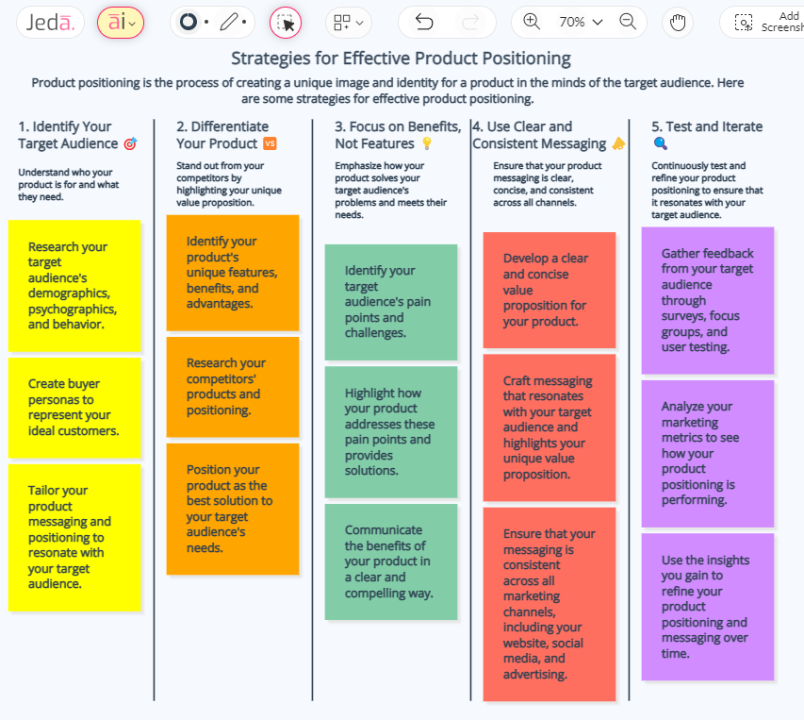
Strategies for Effective Product Positioning.
Introduction
In today's highly competitive marketplace, effective product positioning plays a vital role in capturing the attention of target customers and differentiating your offering from competitors. Product positioning encompasses the strategic efforts to create a unique and compelling perception of your product in the minds of consumers. In this blog, we will explore key strategies and best practices for successful product positioning that can help businesses gain a competitive edge. By understanding your target market, analyzing competitor positioning, and crafting a distinct value proposition, you can position your product effectively and increase its chances of success.
- Understanding Your Target Market
To position your product effectively, it is essential to have a deep understanding of your target market. Conduct thorough market research to identify your customers' needs, preferences, and pain points. By gaining insights into their demographics, psychographics, and behavior patterns, you can tailor your positioning strategy to resonate with your target audience effectively. Use methods such as customer surveys, focus groups, and market segmentation to gather valuable information that informs your positioning decisions.
2. Analyzing Competitor Positioning
A thorough analysis of your competitors' positioning is crucial to differentiate your product in the market. Identify direct and indirect competitors and evaluate their value propositions, messaging, pricing strategies, and target customer segments. By understanding how your competitors position themselves, you can identify gaps or areas of differentiation that can be leveraged to position your product uniquely. Highlighting the unique selling points and competitive advantages of your product can help you stand out in a crowded market.
3. Defining a Unique Value Proposition
A strong value proposition is at the core of effective product positioning. Define the unique benefits and value your product offers to customers. Clearly articulate how your product solves their problems or meets their needs better than competing alternatives. Consider factors such as quality, price, features, convenience, sustainability, or customer service to create a compelling value proposition that resonates with your target market. Communicate this value proposition consistently across all marketing channels to build a strong and consistent brand image.
4. Segmenting and Targeting
Segmenting your market and targeting specific customer groups allows for focused positioning efforts. Identify different customer segments within your target market and understand their specific needs, preferences, and buying behaviors. Tailor your product positioning to address the unique requirements of each segment. This targeted approach helps you craft targeted messaging and positioning strategies that appeal to specific customer groups, leading to stronger customer engagement and higher conversion rates.
5. Emphasizing Differentiation
Differentiation is a key element of effective product positioning. Identify the factors that set your product apart from competitors and emphasize them in your positioning strategy. Highlight unique features, innovative technologies, superior quality, or exceptional customer service to showcase the value customers can expect from choosing your product over others. Focus on the benefits that make your product stand out and communicate them clearly in your marketing messages.
6. Aligning Positioning with Branding
Consistency in positioning and branding is crucial for building a strong and recognizable brand image. Ensure that your product positioning aligns with your overall brand strategy and values. Consistent messaging, visuals, and tone of voice across all touchpoints help reinforce the desired perception of your product in the minds of customers. A well-aligned brand positioning strategy strengthens brand loyalty and enhances the overall effectiveness of product positioning efforts.
7. Iterating and Adapting
Product positioning is not a one-time activity. It requires continuous evaluation and adaptation to stay relevant in a dynamic market. Monitor customer feedback, market trends, and the competitive landscape to identify any necessary adjustments or refinements to your positioning strategy. Iterate and adapt your positioning efforts to ensure your product remains aligned with evolving customer needs and preferences.
Conclusion
Effective product positioning is a cornerstone of successful marketing strategies. By understanding your target market, analyzing competitor positioning, defining a unique value proposition, segmenting and targeting specific customer groups, emphasizing differentiation, aligning with branding, and continuously iterating, you can position your product effectively to gain a competitive edge. Remember, effective positioning is a dynamic process that requires ongoing evaluation and adaptation to stay relevant in an ever-changing market. By employing these strategies and consistently monitoring and refining your positioning efforts, you can maximize your product's impact and drive its success.
#gpt4 #chatgpt #ai #jedaai #diagram #productdevelopment #productdesign #product #productmanagement #development #success #testing #marketresearch